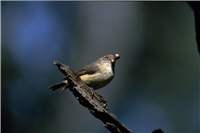Family
Pardalotidae
Genus
Acanthiza
Species
reguloides
Threats/Control Methods - Regional
Land clearing and urban sprawl are pushing this species out of Canberra's bushland reserves and leading to population decline. Its ideal habitat in this region, the Yellow Box/Red Gum Grassy Woodland, is currently considered an Endangered Ecological Community. Free roaming domestic pets also threaten the species, especially in suburban reserves.
Threats/Control Methods - Local
This species is susceptible to changes in the suburban environment and does not survive well in segmented habitats. This was clearly demonstrated by the drop in thornbill numbers visiting the nature reserves of Turner and O'Conner after Barry Drive was built.
Local/Urban Actions
Dog owners should keep their pets on a leash in reserve areas and cat owners can prevent their pets preying on the species by creating a stimulating indoor environment and by installing a cat run or enclosure. Collecting firewood from nature reserves or national parks should not be undertaken, as this will impact on the important foraging and nesting resources.
Common Names
Buff-rumped Thornbill, Buff-rumped Tit, Varied Thornbill
Distinguishing Features
This small bird of about 11cm in size is an olive brown colour across the head, back and wings. It has a dark brown tail with pale tips. The underparts and rump are a very pale creamy yellow (buff) colour, the throat and breast with grey flecks. The feathers above the small pointed beak are a red-brown colour with pale tips.
Survey Techniques
Call and visual identification.
Species Call
A lively, sharp twittering of 'tsip-twit-titch-tseip' and a rapid, tinkling song.
Similar Species
The Yellow-rumped Thornbill (Acanthiza chrysorrhoa ) is very similar but with a bright yellow rump and a spotted head. The Striated Thornbill (Acanthiza lineata ) is slightly smaller and a more orange colour, with dark streaks across its face and breast.
Distribution
This species is found across the eastern parts of mainland Australia, from Adelaide to northern QLD, with highest numbers in the ranges of NSW. Locally, it is found in the suburban fringes of Canberra Nature Park.
Country of Origin
Australia
Conservation (Pet/Pest) Status - Regional
Population numbers have fluctuated in past years, with no recent breeding records suggesting a possible decline (COG).
Conservation (Pet/Pest) Status - National
Secure, not listed under the EPBC Act 1999.
LSCCES Population
Some birds were recorded at the ANBG and at BMt.
Associated vegetation community
This species prefers woodland areas or open eucalypt forest and heath with a thick grass layer.
Limiting Resources
The Buff-rumped Thornbill depends upon a thick grass and shrub layer for foraging and shelter. It spends almost all of its time very low to the ground, needing an area free from introduced predators such as European Red Foxes (Vulpes vulpes), Dogs (Canis familiaris) and Cats (Felis catus).
Breeding
The breeding season begins in August. A breeding pair builds an untidy domed nest of twigs, fallen leaves and grass. It is placed low to the ground in dense shrubs or in fallen hollow logs. A clutch size is 3-5 and eggs are small and white with red-brown speckles. The birds have been seen carrying food for nestlings in October and dependant young are seen in the Canberra region from November to late February.
Behaviour
These thornbills forage busily in small groups, restlessly bouncing around. When disturbed they fly low and flash their buff coloured rump.
Functional Group
Food Species
These birds eat a range of small insects and invertebrates.
Predators
This small bird is prone to attacks from European Red Foxes (Vulpes vulpes), Dogs (Canis lupus familiaris) and Cats (Felis catus).
Interesting Fact
The chinking call of the Buff-rumped Thornbill can be compared to a bag full of ball bearings being shaken.
References - (reader suitability of references, P=Primary teachers, S=Secondary students, T=Tertiary students and researchers)
Books:Morcombe, M. 2000. Field Guide to Australian Birds. Steve Parish Publishing. Archerfield. Australia P, S, T
Pizzey, G. 2000. The Graham Pizzey & Frank Knight Field Guide to the Birds of Australia. Angus & Robertson, Sydney. P, S, T
Taws, N. et al. 2001. Bringing Birds Back: A Glovebox Guide for Bird Identification and Habitat Restoration in ACT and SE NSW. Greening Australia ACT and SE NSW Inc. P, S, T
Veerman, P. 2003. Canberra Birds: A report on the first 21 years of the garden bird survey. Philip Veerman and Canberra Ornithologists Group. Canberra. S, T
Internet: Canberra Ornithological Group (COG). 2004. Birds of Canberra Gardens. COG and the ACT Department of Urban Services. [online]. Available at:http://garden.canberrabirds.org.au/ P, S, T
Online Publications: ACT Government. 2004. Woodlands for Wildlife: ACT Lowland Woodland Conservation Strategy. Action Plan No. 27. Environment ACT, Canberra. [online]. Available at: http://www.environment.act.gov.au/nativeplantsandanimals/threatecspec/woodlandsstrategy S, T
Nix, H. and Cunningham, R. 2006. Birds of the Lower Sullivans Creek Catchment, Canberra ACT. Prepared for the Life in the Suburbs project using data from the Lower Sullivans Creek Catchment Ecological Survey (LSCCES). Australian National University. Canberra. [online]. Available at: http://www.lifeinthesuburbs.com.au/category.php?id=65 S, T

 Top
Top Top
Top